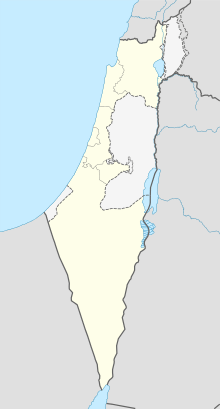Districts of Israel
| Districts of Israel מחוזות ישראל (Hebrew) محافظات إسرائيل (Arabic) | |
|---|---|
| Category | Unitary State |
| Location | State of Israel |
| Number | 6 Districts |
| Populations | 966,700 (Haifa) – 2,024,500 (Central District) 1,350,000 (Tel Aviv District) |
| Areas | 190 km2 (72 sq mi) (Tel Aviv) – 14,190 km2 (5,477 sq mi) (Southern District) |
| Government | District government |
| Subdivisions | City council, Local council, Regional council |

There are six main administrative districts of Israel, known in Hebrew as mehozot (מחוזות; singular: mahoz) and Arabic as mintaqah and fifteen sub-districts known as nafot (נפות; singular: nafa). Each sub-district is further divided into Cities, municipalities, and Regional councils it contains.
The figures in this article are based on numbers from the Israeli Central Bureau of Statistics and so include all places under Israeli civilian rule including those Israeli-occupied territories where this is the case. Therefore, the Golan sub-district and its four natural regions are included in the number of sub-districts and natural regions even though it is not recognized by the United Nations or the international community as Israeli territory. Similarly, the population figure below for the Jerusalem District was calculated including East Jerusalem whose annexation by Israel is similarly not recognized by the United Nations and the international community. The Judea and Samaria Area, however, is not included in the number of districts and sub-districts as Israel has not applied its civilian jurisdiction in that part of the West Bank.
Jerusalem District
Jerusalem District (Mehoz Yerushalayim). Population (2014-12-31): 1,034,200[1]
District capital: Jerusalem.[2]
Northern District
Northern District (Mehoz HaTzafon). Population (2014-12-31): 1,358,600
District capital: Nazareth
- Safed (sub-district) – population: 113,700
- Kinneret (sub-district) – population: 110,500
- Yizre'el (sub-district) – population: 482,300
- Akko (sub-district) – population: 605,700
- Golan (sub-district)[3] – population: 46,400.[4]
Haifa District
Haifa District (Mehoz Heifa). Population (2014-12-31): 966,700
District capital: Haifa
- Haifa (sub-district) – population: 560,600
- Hadera (sub-district) – population: 406,000
Central District
Central District (Mehoz HaMerkaz). Population (2014-12-31): 2,024,500
District capital: Ramla
- Sharon (sub-district) – population: 446,500
- Petah Tikva (sub-district) – population: 685,000
- Ramla (sub-district) – population: 326,400
- Rehovot (sub-district) – population: 566,600
Tel Aviv District
Tel Aviv District (Mehoz Tel Aviv). Population (2014-12-31): 1,350,000
District capital: Tel Aviv
Southern District
Southern District (Mehoz HaDarom). Population (2014-12-31): 1,192,300
District Capital: Beersheba
- Ashkelon (sub district) – population: 512,700
- Be'er Sheva (sub-district) – population: 679,600
Formerly Hof Aza Regional Council with a population of around 10,000 Israeli settlers was part of this district, but the settlements that constituted it were evacuated when the disengagement plan was implemented in the Gaza Strip. Currently only the Coordination and Liaison Administration operates there.
Judea and Samaria Area
Judea and Samaria Area (Ezor Yehuda VeShomron). Jewish Population (2015-12-31) : 407,118, Palestinian population: roughly 1.8 million.
Largest city: Modi'in Illit
The name Judea and Samaria for this geographical area is based on terminology from the Hebrew and other sources relating to ancient Israel and Judah/Judea. The territory has been under Israeli control since the 1967 Six-Day War but not annexed by Israel, pending negotiations regarding its status. In Jewish religious terms it is part of the "Land of Israel", which leads to politically contentious issues. However, it is not considered part of the State of Israel by the UN.
See also
References
- ↑ http://www.cbs.gov.il/reader/shnaton/templ_shnaton.html?num_tab=st02_16x&CYear=2015
- ↑ This district includes areas captured in the 1967 Six-Day War and annexed to Israel in the Jerusalem Law.
- ↑ Occupied in the 1967 Six-Day War and internationally unrecognized annexed by Israel's Golan Heights Law.
- ↑ "Regions and territories: The Golan Heights". BBC. 10 August 2010. Retrieved 18 January 2011.
External links
- Population figures for each district and sub-district(2008)
- Population figures for each district and sub-district(2013)
- Central Bureau of Statistics – detailed breakdown of each district, sub-district, and natural region.
- Urban Israel: Details and pictures about many cities in Israel
